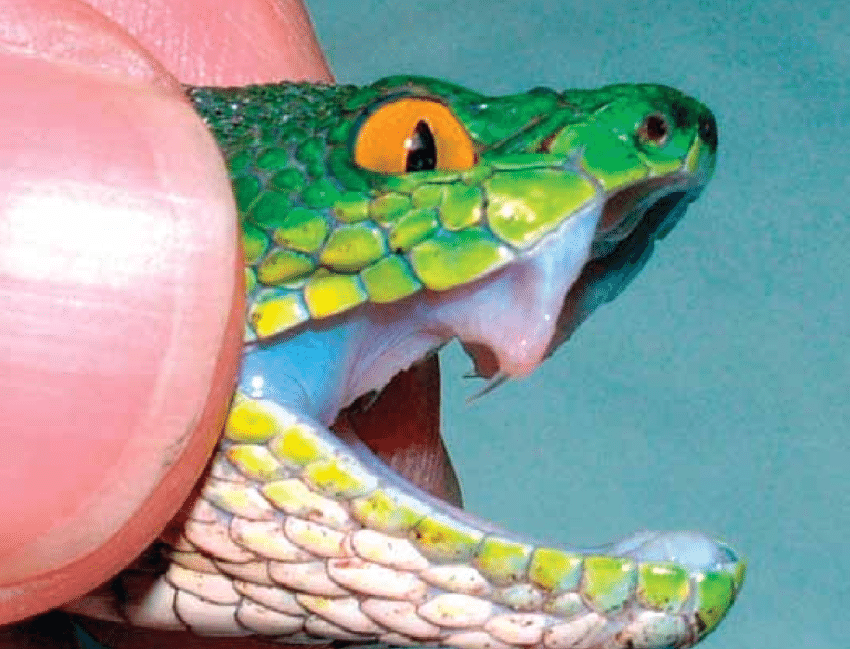Life & Health
Snakes slither out of hiding in summer to make news, biting people coming their way, mainly in hot Tarai and Mid-hills of Nepal, including Surkhet, Pokhara and Kathmandu valleys. Most people reach health institutions seeking treatment of snakebites with few clues about which snake has bitten them and how venomous or deadly the sting is.
In the fiscal year 2021-2022, some 8,000 people came for treatment of snakebites at government health facilities around the country, according to the health ministry. Seven in eight of these cases involved non-venomous stings, its data showed. Only about 1,000 patients actually needed anti-venom treatment, according to the data.
Of them, 100 snakebite patients died – either because they reached hospital too late or because they could not get the right treatment.
Anti-venoms in Nepal
A general anti-venom injection neutralises the poison in patients coming from most snakes, without the need of knowing which snake had made the sting. This polyvalent injection is the only method of treatment available in Nepal.
Monovalent anti-venom raises antibodies against a single species of venomous snake, meaning it requires accurate snake identification, according to Dr Guna Nidhi Sharma, senior head administrator, policy, planning and monitoring, at the Ministry of Health and Population.
A photographic guide has recorded 89 species of snakes from Nepal. But their exact number remains to be determined because large parts of the country are still unexplored from a biological point of view, notes the ‘Venomous Snakes of Nepal, A photographic guide’ by authors including Dr Sanjib Kumar Sharma and Karan Bahadur Shah.

Seventeen species of snake in Nepal are considered highly venomous and dangerous.
“Polyvalent anti-venom is administered to patients because it is a challenge to identify the snakes. Sometimes people are bitten at night,” said Dr Sharma.
Nepal imports the polyvalent anti-venom from India. It is effective in treatment of bites from four common species of snakes found in India: Russell's Viper (Daboia russelii), Common Cobra (Naja naja), Common Krait (Bungarus caeruleus) and Saw Scaled Viper (Echis carinatus), according to the Epidemiology and Disease Control Division.
Saw scaled viper is not yet reported from Nepal.
Deadly snakebite cases in the Tarai and Mid-hills of Nepal have occurred due to highly venomous snakes, Krait and Cobra. Sometimes, people confuse these snakes with other snakes. “This is why patients here are treated with polyvalent snake anti-venom, which is as effective as monovalent anti-venom,” said Dr Hemanta Ojha, chief of zoonotic and other communicable disease control section at the EDCD.
Season of snakebite
Snakes are in hibernation during the winter season. They come out from their hibernation in summer in search of shade or food. As rain water fills in their holes, snakes come out in search of safer places.
So, snakebites are more common during the summer and rainy season, doctors say, when farmers, women and children are more prone to crossing their path.Dr Anup Bastola, chief consultant, tropical medicine, told NepalMinute, “Farmers have to work in their fields, they work bare feet. They get bitten while they are working.”
Dr Ojha added: “Children put their hands in snake holes while playing. Sometimes they mistake snakebite for some other insect bite. This is why many lose their lives.”
Hospital-reported data from the past two decades show that snakebite venom causes about 20,000 yearly hospital admissions and 1,000 deaths in Nepal, according to the Ministry of Health and Population and World Health Organization.
Dr Ojha said: “The number of people bitten by snake may be higher in the country as several cases go unreported. These data are of people coming to hospital for treatment.”
A neglected disease?
According to WHO, snakebite envenoming was a high priority neglected disease in 2017. It has also established a strategic roadmap on snakebites. This strategy focuses on a 50 per cent reduction in mortality and disability caused by snakebite envenoming by 2030.
“The number of snakebite cases has declined this fiscal year, but the count of 100 deaths is still big. People mostly reach the hospital late,” said Dr Samir Kumar Adhikari, assistant spokesperson at the Ministry of Health and Population. “Many patients practise harmful tourniquets and suctions which lead them to disabilities.”
As monsoon rain and summer heat intensify, the government has been supplying anti-snake venom to the snakebite management centres, orienting health workers to properly handle snakebite cases.
A National Guideline for Snakebite Management in Nepal is in place for standardised, timely and effective management of snakebite.
“We are working to meet the 2030 goals,” said Dr Ojha.
Nepal government’s 88 health centres across the country are equipped to handle snakebite cases. Anti-venom injections are stored in its Health Logistic Management Centres across the seven provinces.
Yet, there are some lingering myths about snakes, doctors say, that need busting.
Snakebite myths and realities:
Myth One: Snakes in Kathmandu are not poisonous.
Reality: Snakes in Kathmandu are poisonous, too. According to doctors, the species of venomous krait and cobra have arrived in Kathmandu along with some items of transport coming to the capital from Tarai of Nepal and India. Global warming has helped the species adapt to the different climate and environment of the valley. People will lose life if these highly poisonous snakes bite them, doctors say.
Most of the snakebites in Kathmandu valley have led to hemotoxic effects, harming the blood to clot in human body. Stings from mountain pit viper and green pit viper have led people to bleed. “Abortion has been recorded in some females during their first trimester after the snakebite,” said Dr Bastola.
Referral cases of snakebite from Dhading, Nuwakot, Kavre and Sindhupalchowk have come to Kathmandu, some, Dr. Bastola said, “in a very severe condition.”
Neurotoxic effects after snakebite are less common in the valley. Neurotoxic effects will occur in people bitten by highly venomous snakes.
“People cannot open their eyes, cannot take their tongue out, and their muscles become weak. Such cases are not common here but people must be alert as various species of snakes have started coming to Kathmandu along with bamboos and pipes, among other goods, being transported from the Tarai region,” said Dr Bastola.
Myth Two: Tying a tourniquet, cutting the bite site to let the poison bleed out or using stones to suck blood from the site helps save people after snakebite.
Reality: These techniques gone wrong can lead to amputations, limbs and arms. Tightly tying a body part damages it. Cutting the area leads to high bleeding. No stone can heal a snakebite.
Myth Three: Faith healers, dhamis and snake charmers can treat snakebite patients.
Reality: Patients must be taken to doctors in a health facility for treatment immediately.
Ways to avoid snakebite
How to stay safe?
• Use a torch light if you have to walk in the dark.
• Keep the household clean: cut grasses and bushes, fill holes, and close doors and windows properly.
• Use a stick and hit on the earth surface when walking in the dark. Snake will move away because of its vibration.
• Control rodents to prevent snakebites.
• Avoid sleeping on floor. If it is unavoidable, use mosquito net and tuck it well.
• Check shoes and clothes before wearing if you are in areas where snakes are abundant.
• Wear shoes.
• Never play with snakes, or irritate them. Do not provoke them, they usually do not bite if not irritated or provoked.
Snake bite key facts as per WHO
• Though the exact number of snake bites is unknown, an estimated 5.4 million people are bitten each year with up to 2.7 million envenoming worldwide.
• Around 81 000 to 138 000 people die each year because of snake bites, and around three times as many amputations and other permanent disabilities are caused by snakebites annually.
• Bites by venomous snakes can cause paralysis, may prevent breathing or cause bleeding disorders that can lead to a fatal haemorrhage, irreversible kidney failure and tissue damage that can cause permanent disability and limb amputation.
• Agricultural workers and children are the most affected. Children often suffer more severe effects than adults, due to their smaller body mass.

_11zon1681280198.jpg)




